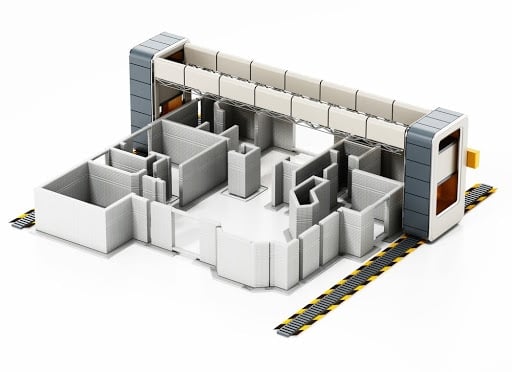While on the campaign trail, President Trump promised to bring manufacturing jobs back to the U.S. and to punish American companies for outsourcing.
Interestingly enough, there are many industries suffering right now not because of a lack of work, rather, a lack of skilled labor.
Economists have predicted for years that we may be facing a shortage of skilled labor across a vast array of industries nationwide.
According to a study conducted by Georgetown University, “the economy will face a shortage of 5 million workers with necessary education and training by 2020.”
The construction industry, however, is already feeling the pain of a labor shortage in many areas throughout the country.
According to a Bureau of Labor Statistics (BLS) report, there are over 200,000 construction jobs that remain unfilled throughout the country, despite heavy demand.
There are also growing fears of a labor shortage amongst Silicon Valley tech firms as well. Many are anticipating a tightening in H-1B visa approvals under the Trump administration.
This would greatly impact the tech industry since a large portion of its workers hail from the Middle East and Asia.
One reason we are facing such drastic labor shortages could be due to the large influx in college enrollments. According to the National Center for Education Statistics, college enrollments in the United States have increased from about 28% in 1985 to just under 41 percent in 2015.
And according to a recent poll, “a scant 6 percent of high school students hope to have a future career in the skilled trades.”
The data also backs up the desire of these high school graduates as well. Employment statistics in the construction industry from the BLS show that the industry has had a very slow recovery in terms of filling jobs since the 2008 recession.
Employment levels in construction currently rest at about the same level as it was in 2000 and make up a smaller share of total employment.
But the data is somewhat confusing. Also according to the National Center for Education Statistics, the number of students awarded a vocational certificate increased 28 percent from 1997 to 2007 with a 34 percent increase in the trades during that same time frame.
There can also be an argument that heavily unionized industries in the trades may be exacerbating the labor shortage.
Throughout the years, labor unions tended to restrict the supply of labor as a means to keep wage rates high for their members.
But BLS data shows that union membership in the private sector has been steadily declining for years, and has just recently hit an all-time low at 13.2% in 2015.
It would seem logical that a reduction in union participation would correlate with an increase in the supply of labor, yet the reverse has been true.
So what gives?
Is the skilled-labor shortage just a myth?
Adam Millsap, writing for The Hill, certainly believes so. In a recent article, he cites minimal wage growth as undermining the possibility of a labor shortage.
Millsap argues that “a tight labor market should lead to higher wages to entice new workers [however]…average hourly earnings only grew by 2.5 percent over the last year…well below the 3-percent-plus growth common before the 2008 recession.”
Millsap makes a good point. Typically, a shortage of supply would raise prices.
In this case, a shortage of labor should raise the price (wage) of said labor so as to entice people to enter into the industry.
But, since 2007, the average hourly wage in the construction industry has increased from $22.59 to $28.52, an increase of 26.3 percent which is relatively identical to the increase in average earnings across the board. And when adjusted for inflation, the average salary increase comes out to be about 9% over the decade.
So why the low wage growth in labor-tight industries like construction?
Probably a variety of reasons. Slow productivity growth and reduced profit margins have left many employers unable to keep up with demand. And investors are finding it much more profitable to keep their capital in financial markets rather than investing in long-term projects.
This is likely leaving many employers strapped for capital and unable to offer higher wages.
Increasing minimum wages in many states also pose a major stress for employers in the trades, specifically as it pertains to entry-level workers and apprentices.
Take for example the state of California, which recently passed legislation to raise the minimum wage to $15 per hour by 2022. Labor unions heavily backed the legislation, but ironically, these same unions are going to have a much tougher time competing for entry-level workers as a result.
If you are looking to get into the glazier industry, for example, the average salary for an entry-level apprentice in the Los Angeles area – which is known to have one of the highest cost of living in the U.S. – is about $15 per hour.
When you consider the intensive labor required for that type of occupation or any other occupation in the trades for that matter, it seems far more likely that a recent high school graduate with limited skills would choose to do something far less labor intensive, like working at a fast food restaurant, considering he would be able to receive roughly the same wage.
And for the average thirty or forty-something who was recently downsized and looking to change occupations, there is no solace found in the trades offering such low starting wages.
While the long-term benefits and salary projections tend to be generous in the trades, it is relatively impossible for someone raising a family to make a career change into the trades for such a low salary.
The skilled-labor shortage does not appear to be caused by a single, or even a few things. It appears to be the result of a variety of different economic strategies compounded throughout the years that has dissuaded young people from entering into the trades.
As mentioned above, few people well into their working years can make the necessary income sacrifices that are required to begin a new career in the trades.
And with government incentives to enter into higher education, it doesn’t seem likely that there will be a rush of young people entering into the trades anytime soon either.
Employers in the trades are going to have to get quite crafty if they want to attract new talent. Government can ease their burdens by reducing tax rates and eliminating red tape which hinders competition and growth in the industries, but if nothing changes soon, we could be looking at a severe problem in the years to come.
RELATED:
• Retiring Baby Boomers Only Half the Problem of Declining Labor Force
• 3D Printers to Revolutionize Manufacturing in 2017
• Why We Should Pay Attention to Labor Force Participation, Not Just Unemployment











